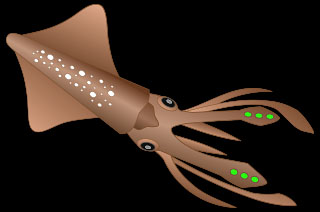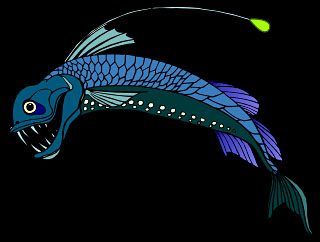Deep Sea Bioluminescence
|
|
|
|
||
|
|
Deep in the ocean, where sunlight can no longer penetrate, lies an incredible world of darkness. And against all odds, this just happens to be the location of one of nature's most impressive artificial light shows. The creatures here have evolved their own ways of dealing with the darkness. Through a process known as bioluminescence, they have developed the ability to use chemicals within their bodies to produce light. If you have ever seen a firefly then you have witnessed the same process in action. Bioluminescence is mainly a marine phenomenon. It is not found in freshwater. On land, it is seen only in a few species of fungi and insects. It is the oceans where this unique ability achieves its highest form. Hundreds of species of fish and invertebrates flash their colors in a light show that can sometimes rival the streets of Las Vegas.


Bioluminescence occurs when certain chemicals are mixed together. This effect is very similar to that in green light sticks. When the seal in the stick is broken, the two chemicals mix together and give off a soft, green glow. Most of the light created by marine organisms is blue-green in color. This is because blue light travels best in water, and because most marine organisms are sensitive to blue light. A notable exception is the Malacosteid family of fishes, also known as Loosejaws. These fish can produce red light and can see it when others cannot. This gives them an advantage by allowing them to see their prey while without making their presence known. Marine creatures produce light with special organs called photophores. At least two chemicals are required to produce bioluminescence. The first is known as a luciferin. This is the chemical that actually creates the light. The second chemical is called a luciferase and is the substance that actually catalyzes the chemical reaction. When these chemicals are mixed together in the presence of oxygen, light is produced. A by-product of this process is an inert substance called oxyluciferen.
 Some of these creatures give off light continually. Others flash their lights on and off by mixing their chemicals on queue or by covering their light organs with a flap of skin. The flashlight fish has a light-producing organ near its eyes that is covered with an eyelid-type flap. The fish can flash its light by opening and closing this flap. These creatures produce light for a variety of reasons. For some, it is a warning to stay away. For others, it is a form of camouflage. Certain species of shallow water squid give off light to blend in with the moonlight. Some creatures use their light for navigation. Certain fish species use bioluminescence as a form of "night light". Some use it for communication. Certain species of crustaceans send out coded signals to others of their own kind during mating season. Other creatures use bioluminescence as a trap. The anglerfish uses a lighted "lure" on the top of its head to attract its prey. When the unsuspecting animal is within striking distance, the angler vacuums it down with a lightening-fast snap of its powerful jaws. Whatever the reason for producing this dazzling light show, it remains as one of the natural world's most bizarre and spectacular facts.
Some of these creatures give off light continually. Others flash their lights on and off by mixing their chemicals on queue or by covering their light organs with a flap of skin. The flashlight fish has a light-producing organ near its eyes that is covered with an eyelid-type flap. The fish can flash its light by opening and closing this flap. These creatures produce light for a variety of reasons. For some, it is a warning to stay away. For others, it is a form of camouflage. Certain species of shallow water squid give off light to blend in with the moonlight. Some creatures use their light for navigation. Certain fish species use bioluminescence as a form of "night light". Some use it for communication. Certain species of crustaceans send out coded signals to others of their own kind during mating season. Other creatures use bioluminescence as a trap. The anglerfish uses a lighted "lure" on the top of its head to attract its prey. When the unsuspecting animal is within striking distance, the angler vacuums it down with a lightening-fast snap of its powerful jaws. Whatever the reason for producing this dazzling light show, it remains as one of the natural world's most bizarre and spectacular facts.
Deep Sea
Creature Database
'



